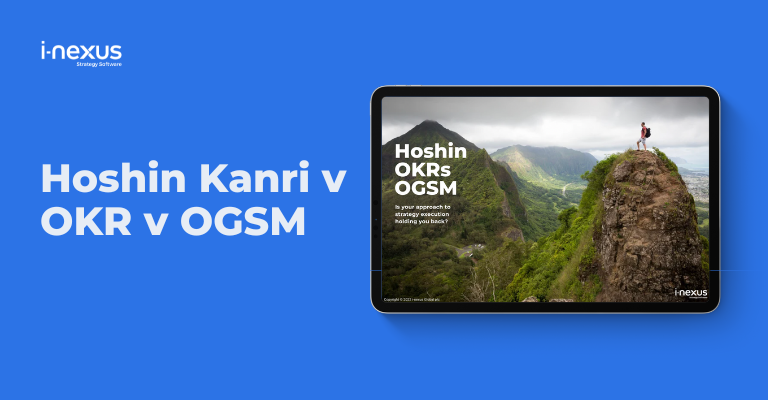The Hoshin Kanri cascading theory of catchball is commonly seen as the pinnacle of how to close a strategy-to-execution gap and drive buy-in of your plan. Tweaking your goal cascade with the catchball process helps you to gather feedback, improve quality and improve your chances of success. Here's what you need to know and how to implement it.
Written by: James Milsom, Head of Marketing
The catchball method is part of a cascading theory used in Hoshin Kanri.
This goal creation and communication and buy-in tool is typically used in a Hoshin Kanri / policy deployment framework, but its application lives beyond that realm.
Often described as a 'driving force of alignment, clarification and employee involvement' for organizations like Toyota, this technique is the answer to helping you plug the people gap that exists in most strategy-to-execution analyses - gathering feedback on your goals.
Here's what you need to know about the catchball technique and how to implement it.
What is the catchball process?
A logical question to start with, but all too easy to ignore and skip to the process itself.
Think of strategic planning as typically exclusive. The corporate level will set a plan and cascade is down throughout the business. However, with the catchball process, there's a conscious attempt to pass goals down and empower teams to create their own plans from this.
Why? Because local level business units and employees know their markets better than anyone.
This goal cascading theory is, much like the x-matrix, a headline of the Hoshin Kanri framework.
Catchball is the process whereby a company's vision is broken into individual goals. These are then cascaded through a series of constructive conversations between different organizational levels and units, ending with everyone understanding how they contribute to that vision.
You’ll often hear the metaphor that’s it’s akin to a game of toss. Passing from the top down to the bottom, everyone necessary to the process can share their views and opinions on the goal and throw the ball back should it fail to stick.
As an element of the Hoshin Kanri approach, it’s a decision-making system that makes for involved, high-quality plans that have the buy-in necessary to achieve your goals.
By deploying the catchball process your business will be in a position where strategic information is shared, reviewed, and refined at multiple levels - reducing the gap of corporate, business, and functional strategies.
Put another way, it’s like a game of baseball where hitting a home run isn’t necessarily the aim. Instead, there’s a systematic approach of passing the ball from one base to another, and, should goal not stick, throwing it back for refinement.
Process design for catchball
The essence of catchball comes down to collective agreement, however, you must establish how this can be reached. This is what is referred to as process design.
There are 3 different methods that can be used to create agreement:
1) Ringi system
Originating from Japan, this approach boils down to unanimity in the sense that all members involved in catchball must reach an agreement at each stage.
It's great for resolving herd mentality, where our ability to comprehend and form our own opinions is curtailed by pressure to conform.
This promotes individual thinking which is then aggregated to a level where all can agree.
2) Social judgment
Social judgment theory suggests we draw conclusions on the basis of available information.
If a Head of Marketing values adding a new communication channel to their campaign mix because of its ability to amplify messaging, the Head of Finance may see less value in this, instead of focusing on the negatives such as the cost and immediate ROI.
In catchball, we must ensure that we can understand the points of view that form judgments and use social judgment theory to aggregate them to enable a consensus and buy-in.
3) Delphi
Emanating from a 1950s US defense research project, this approach ensures that individuals can air their own judgments in a way conducive to reaching a consensus.
How? Individual contributions can be made by 'structured communication' such as a survey.
This removes any prejudice around someone's role, background or authority, instead focussing on the issue at hand, creating a space to collaborate and move forward with the right goals.
Of course, this can also run the risk of an endless exercise, therefore it's crucial to select a strong number of participants to result in an agreement.
Now that you've designed the method to ensure proper communication and assessment, it's time to step up to the plate and kick-off our game of catchball.
Communicating and gathering goal feedback
As the team takes the field, you’ll want to make sure the key players are able to take position.
From the executive team through to the frontline staff, it’s all about using the strengths of every player on the team to put on a classic game of ball when it comes to your strategy.
The first stage of feedback
Once the pitcher (executive team) has thrown the ball, the goal is now in-flight, making its way to the first respondent – the batter (senior management).
Now, the initial feedback of senior management will be key here.
Their response, or bat, is key to finding the next logical person in the process, the catcher (middle management). Their role is to take the initial goal and begin to assess its fit for the function, looking at the available resource, skills, and other potentially conflicting workstreams.
Not every goal will work at this stage, but that’s why the catcher is so important here. It’s all about the social validation of the initial goal.
They need to be able to review and then throw the ball (or goal) out to the first base, second, and so forth.
As the ball transfers from each base, reaching its way to frontline staff, the goal is being refined and improved, finding its way ever-closer to home plate (the end destination).
Negotiating and tweaking the goal
But what if the goal doesn’t get buy-in from a particular level (or the catcher can’t quite reach for the ball)?
This is where the ball needs to be thrown back to the previous player, and that player then adjusts the goal so that it can be correctly received (bought-in as an acceptable idea) by the next player.
The result is that everyone has participated in the goal definition process, aligning and working towards achieving the corporate, business, and functional vision, having given their input on each goal.
Do this consistently, and the results will pay off.
How to ensure success with your catchball goal cascade
We all love getting to dissect the perfect game, the perfect pitch, and the science behind it.
Well, now is the time to do just that with catchball. Here is a checklist of what you need to do to ensure quality feedback and better goal creation.
1) Leadership is where it starts
Strong leadership has a trickle-down effect.
As a leader, it is your role to make sure that everyone necessary can participate in the game.
A healthy, fighting fit team is one that will provide you great results every time.
It is a leader’s role to ensure in the game of catchball that the batter, catcher, outfield players and everyone involved can participate in a way that proves a great use of their time and abilities.
That means giving each player the time to investigate the plan and deliver feedback before passing the ball to the next player, or throwing the ball back.
2) Empower your team
They’re part of your organization for a reason, so you need to make sure they’re empowered to participate in this process.
Equally, you need to ensure you’ve briefed them on the rules of the game, and they know the role they’re set to play.
But above all else, you’re all playing for the same result – so every constructive comment should be welcomed.
Provide places where collaboration and feedback are encouraged, and no opinion is wrong.
And the risk of passing the ball to a disengaged, unprepared fielder?
They’ll disrupt the process or, at worst, accept the goal at face value, which can impact the buy-in and ultimate success of the plan.
3) Home field advantage
Catchball involves your organization working on the same page, and it’s crucial that you don’t overlook choosing the right venue.
It’s your role to select the perfect location to play ball.
Here’s what you need to keep in mind when choosing the field of play:
-
- Is your organizational culture one that promotes inclusion and freedom of information?
- How much time is going to be required from each player in the game?
- Do those involved prefer team meetings featuring every player, or do they perform better in one-to-one sessions where the ball is passed from each passer to the next in a structured, focused private location?
Bottom line, when scouting the right location, make sure it’s one where every player can perform to their best abilities and aren’t left inhibited by culture, time restraints, and the method in which the game is played.
Catchball case study
In practice, involving your employees in deploying your strategy, let alone goal creation, is difficult to achieve.
However, when executed correctly, the catchball process should:
- Drive greater belief in goals
- Improve your team's understanding of the work needed to deliver this, and
- Be motivated and clear on how they contribute to delivering business-critical results.
While Hoshin Kanri has been adapted end-to-end by organizations such as Xerox, the catchball process has also been modified.
The catchball process in automotives
The Rover automobile group, based in the UK, was the subject of a case study by Charles Tennant and Paul Roberts in 2001, and illustrates a fantastic evolution of the process.
When Rover wanted to roll out its version of Hoshin, Strategic Policy Deployment, it stumbled at the annual objective setting stage. Three proposals were made for defining these goals:
- A research team identifies major issues and develop a plan without consensus from the teams beneath
- Small groups of executives would create the plan, achieving a small amount of consensus
- A significant sample of management-level personnel would help define the plan and achieve considerable buy-in of the strategy
"The first option was considered to be unsuitable, based on the realisation that the quality strategy team would not be able to identify all major issues intuitively, let alone accurately identify effective remedial actions.
The second option, although preferable to the first, would only be based on minor consensus, and would not take sufficient account of the major company issues and process dependencies.
Therefore, the third option was selected based on the premise that as significant company resources would be expended on the deployment of the quality strategy, then it was justifiable to allocate commensurate levels of resource and time to develop, clarify and communicate the strategy."
Summarizing the Rover adaptation
Rover's adaptation of the catchball process came to:
- Interviewing a small number of key stakeholders from each business unit
- Developing initial goals
- Surveying across functions to ask what each interviewee believed the goals should be for their areas (but required a vision before any interview would move to how can we bridge a gap between your vision and the desired state)
- Results analyzed and fed back into the plan
- Workshops then reviewed the plan in a wider sense
- A new proposal was made for the plan
- This was agreed with each unit owner
- Sign off from a central unit (such as a EPMO or Strategy Realization Office)
Their application offers a unique insight into the practicality of catchball, and the Tennant paper should be recommended reading for any reader.
And remember, Hoshin's catchball can also be used in OKR, as we cover in our eBook below:
How catchball affects your strategy to execution gap
The catchball process is an invaluable weapon for conquering the ever-growing strategy to execution gap:
- It will help you gain a greater realization of how feasible your plans are, and gauge the level of success possible through a motivated, bought-in team.
- It gives clarity on who's going to be able to execute each element and ensures your organization can deliver an aligned game plan.
- It provides a 360-degree understanding and affirmation of what will work and constant re-affirmation of this fact.
So, remember these five factors when it comes to playing ball with the catchball process:
- Lead by example and provide an environment where the process can succeed
- Encourage discussion and participation
- Empower everyone involved in the process
- Choose the right location for the game
- Rinse and repeat the process for continuous improvement.
Ready to improve your goal cascade?
Now that you’re ready to play ball with the catchball process, it’s time to take it to the next level with the W process.
Watch the video below to learn the 5 step process that’ll make you a master at catchball:
Learn more about closing your strategy to execution gap
Click here to learn more about closing your strategy to execution gap – or take a look at these content recommendations:
- How to use countermeasures to learn from your delivery challenges: Every day is an opportunity to improve, and with a countermeasure process in place, you can learn from your strategy delivery challenges.
- Assess your strategy to execution gap: Complete StratexAssess today to get a crystal clear idea of where your strategy delivery is letting you down.
- Download our Hoshin Kanri eBook: Read how Hoshin Kanri is supporting organizations to drive great business results, how two businesses have used the methodology to build their business systems, case studies, and more.
- OKR v OGSM v Hoshin: Find out the role that your approach to strategy execution has on your ability to deliver mission-critical goals in this eBook.
About the author
James Milsom is Head of Marketing at i-nexus. James has wide-ranging experience in markets such as telecommunications, energy, education, and software.
As Head of Marketing, his drive is to raise awareness and understanding of the challenges facing enterprises in delivering strategic objectives and transformation amidst changing markets and the obstacles traditional tools and methods present leaders.
If you’d like to talk more about Strategy Execution, reach out to James on james.milsom@i-nexus.com or connect with him on LinkedIn for the latest insights.




